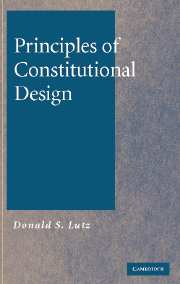Book contents
- Frontmatter
- Contents
- Preface
- Acknowledgments
- Principles of Constitutional Design
- 1 Constitutionalism: An Initial Overview and Introduction
- 2 Sovereignty
- 3 Popular Sovereignty
- 4 The Separation of Powers
- 5 Analyzing the Interaction between Popular Control and the Separation of Powers in the Amendment Process
- 6 Matching a Government to a People
- 7 An Overview of the Constitutional Design Project
- 8 An Underlying Constitutional Logic: Rational Actors?
- Index
5 - Analyzing the Interaction between Popular Control and the Separation of Powers in the Amendment Process
Published online by Cambridge University Press: 29 July 2009
- Frontmatter
- Contents
- Preface
- Acknowledgments
- Principles of Constitutional Design
- 1 Constitutionalism: An Initial Overview and Introduction
- 2 Sovereignty
- 3 Popular Sovereignty
- 4 The Separation of Powers
- 5 Analyzing the Interaction between Popular Control and the Separation of Powers in the Amendment Process
- 6 Matching a Government to a People
- 7 An Overview of the Constitutional Design Project
- 8 An Underlying Constitutional Logic: Rational Actors?
- Index
Summary
Why the Amendment Process Is Important in Constitutional Design
We have seen that framers of constitutional republics tend to increase the level of separation of powers as they increase the level of popular control. This principle of constitutional design seems to emerge from some logic inherent in the design process rather than from designers following explicit, articulated normative rules. It was suggested in Chapter 2 that the inherent logic of constitutional design results from humans, on the one hand, seeking to create a supreme power that allows an expanded pursuit of self-preservation, liberty, sociability, and beneficial innovation and, on the other hand, seeking to prevent that supreme power from itself threatening these pursued values. As a secondary principle, framers of constitutions tend to balance the consequences of constituency size with the consequences of legislative size to produce a primary legislature whose size approximates the cube root of the population.
Put another way, under conditions of popular control the elective legislatures that are the core of a constitutional republic should have constituencies that as are as small as possible; but also, under conditions of popular control, the legislatures should not be so large as to fall under the control of legislative elites. As the population of a constitutional republic grows to a size where the attempt to achieve this balance results in both a constituency size and legislative size too large for preventing government itself from threatening popular control, a second house is usually added to the legislature and gradually strengthened as the population grows larger.
- Type
- Chapter
- Information
- Principles of Constitutional Design , pp. 145 - 182Publisher: Cambridge University PressPrint publication year: 2006



